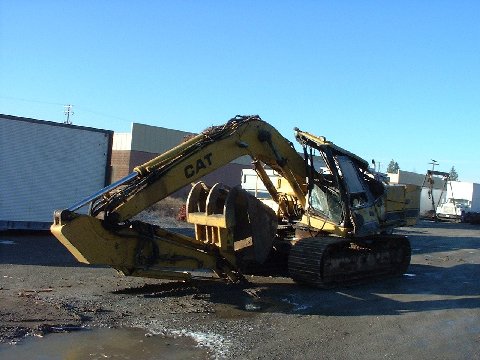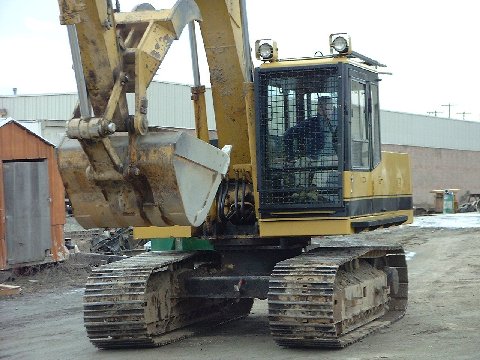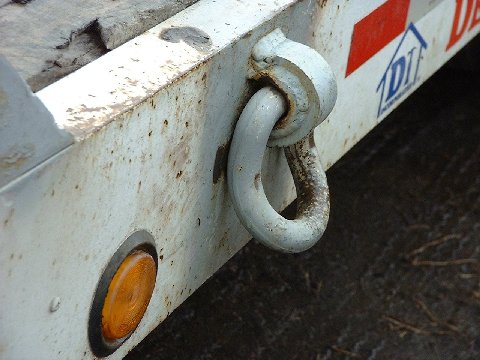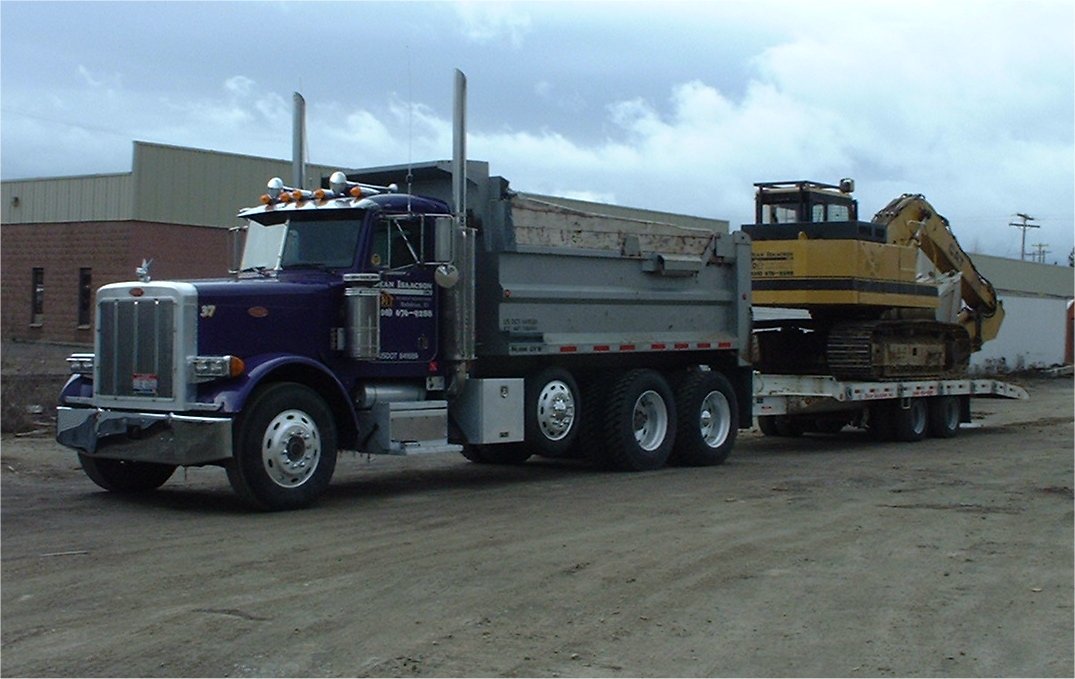I cannot describe the feeling but I know you’ve felt it before. The feeling you get when you know something is enormously wrong but just before the full impact hits you. It was only five fifteen but it was dark outside. I stepped outside my truck and was looking back at the trailer. From where I stood, it appeared the trailer had collapsed and the thirty-two thousand pound excavator was missing. Certainly, I would walk back and find the machine at the edge of the road. As I approached the rear of the truck, it was worse than I expected – the excavator was rolled over in the ditch, tracks up in the air. The trailer was upside down and there were chunks of asphalt all over the road.
For what it could have been, it wasn’t a bad wreck. Thank God, nobody was killed or injured. Nobody was around at all. I had been traveling slowly on this lonely winding road just to avoid an accident like this. I kept my speed fifteen to twenty miles an hour on most of this road, increasing to twenty-five on a couple straight portions. The road was wet and it was dark and misty outside. I remember telling myself that I wasn’t in a hurry and I didn’t care if it took me an hour to wind my way through the ten or twelve mile section of twisted road. You’d kick yourself if you screwed up like this while messing around and you’d have to agree you had it coming. But it was a big shock to see that big hunk of equipment turned-over in the ditch after taking every precaution to make certain it wouldn’t happen.

My first call was to my son, Andy, who was probably six or seven miles ahead of me in his pickup. He worked with us through the night to recover our excavator. As I made my call to 911, a man in a minivan, named Weedenhoff, pulled up and started asking questions. I politely answered and offered that help should be on the way soon. He then pulled to the end of the wreckage and switched on his rotating blue beacon. He was an undercover detective and it was great to have his assistance while waiting for the sheriff’s deputy and the State Police.
A Kootenai County sheriff’s deputy and the Idaho State Police were soon on the scene. They poked around for a couple hours, asking questions and such. We walked ourselves through several possible theories that could explain the wreck until we came to the conclusion the excavator must have slipped between the looped chain at the front of the trailer. The shifting of the weight caused the trailer’s front edge to gouge the road, breaking the bead of the front outside, passenger side trailer tire. After this, a rear chain snapped and the excavator rolled over into the ditch. The force of the exodus turned the trailer upside down and forced the pintle out of the hitch.
They affirmed for certain that I had been creeping, as I said, because the trailer was less than eight feet away from the excavator and not more than eight to ten feet ahead of it. The truck and trailer were no longer connected by pintle hitch but the chains, wires and hoses were still altogether, connected – and undamaged.
The State Police asked me questions about my last inspection, who performed it and how I connected my chains. I assured her my truck had been inspected by the State of Washington within the last six months and the sticker was still on my windshield. I explained how I would loop a three-eighths transport chain over the tracks of the rear of the excavator, which is up to the very front of the trailer, and ratchet that tight. The front of the excavator, which was about the middle of the trailer, was secured with two lengths of transport chain crossed in an “x” fashion and tightened with binders. She thought that was very good, though she admitted as good as that was, somehow the excavator still must have shifted. She surmised it could have been a twist in the chain that straightened and loosened as we traveled along, or something along that line.
One thing about it, every time the Idaho State Police or the Washington State Patrol inspected my equipment load, they liked the way I secured my equipment. They would always comment that it was good to find a trucker who knew his chains. However, after seeing one of my excavators belly-side up in the ditch, knowing that I had secured the load “properly” and driven with such caution, left me with such a helpless feeling. I thought it would be unwise to ever haul that machine again behind my dump truck. But help was on the way.
I realized early I would not be using my trailer to transport the retrieved machine. Not only were four welds broken at the connection of the dove-tail but several hooks were torn off the side of the trailer, one wheel was damaged and the tire had a ripped bead. So I called my friend, Ron Mills, whom I knew to have a low-boy trailer. He didn’t think his trailer would do the job because of the way the wreckers would have to pull the machine on the trailer. He suggested I call Kim Johnston. He had a detachable unit that would work well. I called Kim and he agreed to be on call for when we needed the haul.

While I was at it, I called my mechanic, Ross Point Truck Repair. They sent out Larry Ford, who was very familiar with this machine. I wanted him to be out here to give advice and monitor all mechanical operations of the excavator. The last thing I wanted was to destroy the engine or the hydraulics by someone starting the motor, or carelessly maneuvering the machine. He proved to be invaluable.
It was two hours after the wreck before the tow truck showed up. He had been waiting for some time a few miles up the road at a location given him in error. I wasn’t sure why he didn’t keep driving till he saw us, except that maybe he thought the wreck would come to him. Nonetheless, he was a very competent operator and after reviewing the damage determined it would take two trucks to right this large machine.
When the second wrecker arrived we went to work getting the trailer righted and out of the way. This took an effort from two wrecker trucks, chains, blocks and my dump truck. We had to twist the trailer perpendicular to the road, turn it over back on its tires and then twist it parallel to the road again. It was a small operation but one that had to be executed carefully.
With the trailer hooked to the dump truck and out of the way, we set out to recover the excavator from the ditch. The flaggers had arrived and the police left. At the change of the guard we let the dozen cars pass by that had been waiting the last half hour or so. The wrecker operators were carefully planning the recovery and maneuvering their trucks into position. They set up a couple different times and consulted with my mechanic before they were comfortable with their strategy. It was about eight o’clock now.
It took over an hour for them to make all their connections to the excavator and test their chains and cables. This was not a matter of hooking onto the tracks and pulling the machine over. On the contrary, there were many considerations. Not only was the weight of the machine a factor, but the narrowness of the roadway was a concern. On the opposite side of the road from the ditch was a very narrow shoulder and a steep downward bank. Both trucks would approach the excavator on less than a forty-five degree angle. They had to figure out a way to bring the machine all the way over, while restraining its fall at the same time and, all the while, bringing it over evenly so not to damage the road or machine.
We sent for old truck and tractor tires to line the road and absorb the fall. I called for Kim Johnston. It was now a little before ten o’clock.
We decided once the excavator was righted, we would not try to start the engine but would remove the final drives so we could roll the machine and we would disconnect the hydraulic lines so we could maneuver the boom and stick into place. This turned out to be a good plan because we discovered later the engine cover was destroyed and dirt had entered the motor through the crushed oil cap.

When Kim arrived the wrecker operators were just getting the trucks ready to set up. After introducing everyone, we let all the traffic through which had built up for the last forty-five minutes. Seven cars went by; they would be the last for the night. This was good because we would have the road blocked completely for the next three hours.
While the wrecker operators were finishing setting chains and chokers, Kim looked over my trailer and asked me questions about my setup. He pointed out the danger in the looped chain on the rear of the excavator. He said that even if I had that crushing tight, the machine could still slip sideways within it. Once a thirty-two thousand pound machine starts to slip, there is no stopping it, especially when traveling through a corner that is sloped to the outside. Then he showed me his system. “I never use less than a half-inch chain,” he said. “It might sound like overkill but these can be life and death situations.”
When he stated it like that, it made perfectly good sense. When we considered the weight of the machine, the capacity of the four points of three-eighths transport chain did exceed the weight of the machine but not by much. However, when you consider your chain and binder setup, you must consider all components when rating your system. Even though I used grade-seventy chain (transport) my binders were only rated the equivalent of grade-forty. That was a blow. I had not even thought of that.
Kim told me all chains should be as short as possible to eliminate loose links and have less chance of week links. I had seen haulers use less chain than I did and it always seemed dangerous to me. But he explained that all chains should have short throws and should be at a forty-five degree angle from the points of connection, both longitudinally and laterally. This made sense: The chains should hook on the tracks and pull in opposite directions while extending away from the machine in a compound forty-five degree angle.
Because the rear of the machine would back all the way to the front of the trailer, that would pose another problem. How do you get a forty-five degree angle when the hooks are eighteen inches toward the opposite end of the machine, or short of the front of the trailer? It was because of the setup of the trailer that we would loop a chain over the tracks and put pressure on the machine between these two hooks. After looking the problem over, Kim suggested that I grab the frame, the I-beam, through the triangle of the tongue area of the trailer. This would give a forty-five degree pull toward the middle of the width of the trailer, though it would give only about a thirty degree pull away from the machine. Not the best, but good and much better than our previous setup.
When connecting to the frame in the tongue area, we are not grabbing the top of the I beam where the cross member welds together. Instead, we welded a half-round pipe at the crotch, or intersection, of the two beams, from the top of the I-beam to the bottom to protect our chain. Now we wrap the chain through the crotch and hook the bottom, outside of the I-beam with a grab hook.
We replaced the four bolt pintle hitch on the dump truck with a six bolt unit. This gives a higher tongue weight, even though the four bolt was more than adequate. However, the six bolt hitch has a higher breakout rating and that might have prevented the trailer from completely turning over.
I don’t lose a lot of sleep over business problems. God said that everything works together for good (Rom 8:28) and I rest upon His promises even if I can’t see the outcome or understand it. Nonetheless, I do try to analyze my mistakes so I can learn from them. In my mind, I have gone over and over my operations before the accident. Did I double check my chains? Did I look for kinks or twists? Did I check my binders? Were the tracks sitting upon a rock? You know, I cannot tell you with all certainty because I think I checked and double-checked and obviously something broke loose. But I have good confidence in the future because I have a sound strategy for my chains and real-life reasons to check, double check and triple check my chains.

Here is a view of beefed up trailer loops. You can see we got our equipment fixed up well thanks to the crew at Ross Point Truck Repair in Post Falls, ID (the truck was not damaged). And you got to admit, that is one beautiful purple Peterbilt! — and yeah, that’s a flying pig on the hood!



